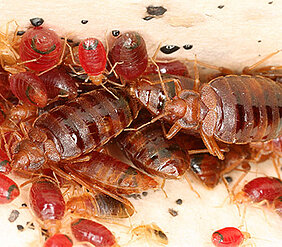Tracking down a bloodsucking pest
02/02/2016An international team of scientists has managed to sequence the genome of the bedbug. Among them are neurogeneticists from the University of Würzburg's Biocenter. They studied genes that control the circadian clock, secretion and moulting processes.

Sensitive people feel the urge to scratch at the mere thought of them: bedbugs. Only a few millimetres in size, the tiny insects have been on the rise worldwide for a few years. Having been all but eradicated in many countries after the Second World War – probably owing to the generous use of pesticides – they are presently "resurging".
Resistance is widespread
Scientists believe that the booming long-distance travel business, trade globalisation and the popularity of second-hand items are to blame for the fact that bedbugs have re-established themselves as household pests on all continents. This is exacerbated by the fact that the insects are now resistant to most classes of insecticides.
A team of scientists from the US, Germany, India, France, Taiwan, the UK, New Zealand and Switzerland has now managed to sequence the complete bedbug genome. Among them are Christian Wegener, Professor of Neurogenetics at the Department of Neurobiology and Genetics at the University of Würzburg's Biocenter, and his co-workers, the two postdocs Dr. Pamela Menegazzi and Dr. Nicolai Peschel. The work was coordinated by researchers from the University of Cincinnati; the sequencing was performed at Baylor College for Medicine in Houston. The results are presented in the latest issue of Nature Communications.
Researchers from the Biocenter involved
Usually, the scientists at the Department of Neurobiology and Genetics prefer researching the fruit fly Drosophila. Two reasons prompted them to tackle the genome of bedbugs: "After a meal of blood, bedbugs are so full that they can hardly move. This makes them susceptible to potential predators," Christian Wegener describes one of the reasons. However, bedbugs know a trick which allows them to reduce this hazard: They secrete great amounts of liquid in short time which increases their mobility.
This process is controlled by peptide hormones that bind to so-called G-protein-coupled receptors. "This receptor class also exists in humans where it is a target for a number of drugs," Wegener explains. It is quite possible that they are a suitable target for a new kind of insecticides in bedbugs. This could turn the tide in the ongoing race "humans vs. bedbugs", in which the bedbug is clearly ahead at present.
Together with his collaboration partner Professor Klaus Reinhardt from TU Dresden, Wegener is interested in the signals that trigger the secretion and moulting process. "The decisive stimulus might be provided by stretch receptors in the bedbugs' skin," the neurogeneticist says. After all, these receptors are the first to register when the bedbug's body engorges with blood, thereby indicating the availability of nutrients for growth.
The sucking of blood sets the circadian clock
The second question that intrigued the Würzburg team was how the circadian clock of bedbugs works. "In most living organisms, this clock is set by daylight. Bedbugs, in contrast, are nocturnal insects, so for them sucking blood is also a key driver of the circadian rhythm," explains Pamela Menegazzi. What genes are responsible for this? How do they differ from those of other insects? and How have they changed in the course of evolution? To find answers to these questions, the scientists searched the bedbug's genome.
"Sequencing the genome": To the ordinary persons this sounds like a routine task that is mainly performed by sequencing machines today. Where is the scientific achievement in this? "The process is far more complicated than that," says Christian Wegener. He compares the genome sequence to a tablet inscribed with a continuous sequence of unknown characters without gaps. Even if you knew which sound belongs to which character, it would still be impossible to determine where a word begins and ends, not to mention its meaning.
14,222 genes identified
So the researchers' work is like a jigsaw in the form of a video game played in a special genome browser. All teams involved compile their results there, which are subsequently verified by experts in computation biology. 14,222 genes of the bedbug have thus been identified by the scientists – 13,953 had been predicted automatically. For comparison: The human genome contains a little over 20,000 genes.
Hidden inside is the explanation for many a strange characteristic of the bedbug. For example, the insect exclusively feeds on blood, so in order to survive it needs to extract all nutrients from it. Once they have ingested a "meal of blood", bedbugs can survive for a whole year without eating. So trying to "starve" an infested mattress by sleeping on the living room sofa for a couple of weeks is doomed to fail.
A strange reproduction practice
"Traumatic insemination" is the scientific term used to describe the mating practice of bedbugs in which the male pierces the female's abdomen with his penis and injects his sperm through the wound into her abdominal cavity. How such brutal behaviour could develop during evolution and how infection is avoided are other questions the researchers are interested in. The scientists believe that knowing which genes are active in these processes could also be beneficial to a number of human diseases.
Targeting the genome of 5.000 insects
Sequencing the genome of 5.000 insects: That is the goal of the "i5K" project which includes the bedbug genome. According to Wegener, the international collaboration serves as a kind of reference for all future projects. "The fact that the sequenced genome was subsequently examined manually by numerous scientists assures the high quality of the results," the geneticist says. But even this approach does not guarantee that every single gene has actually been identified.
Unique features associated with bed bug biology revealed through sequencing and manual curation of the Cimex lectularius genome. Joshua B. Benoit, et al. Nature Communications, DOI: 10.1038/ncomms10165
Contact
Prof. Dr. Christian Wegener, Phone: +49 931 31-85380,
christian.wegener@biozentrum.uni-wuerzburg.de









